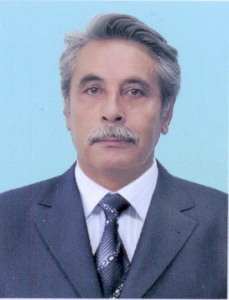Alisher Khaidarovich Ibragimov (1957 - 2024)

On May 12, 2024, Alisher Khaidarovich Ibragimov – Head of the Laboratory of Instrumental Seismology and Seismometry of the Institute of Seismology of Uzbekistan Republic’s Academy of Sciences - passed away.
Alisher was born in the city of Fergana on May 7, 1957, into a family of well-known journalists in Uzbekistan, which soon moved to Tashkent. He recalled with great warmth his childhood years spent in Fergana and almost every year he visited his small homeland, where his relatives on his father's side still live. Fergana Valley is known not only for the world's most delicious fruits, simplicity and hospitality of its people, but also for one of the highest levels of seismic activity in Central Asia. During the historical and instrumental period of observation, many earthquakes have occurred here, causing shaking with an intensity of 8 and 9 points. He often said that his experiences in his parents' aseismic, earthquake-resistant, mud-brick house greatly affected his choice of seismology as a profession.
Alisher came to the Institute of Seismology right after graduating from high school in 1974. He was hired as a technician in the laboratory of “High pressures and temperatures”, which everyone jokingly called the laboratory of “Hypertension”. At that time the laboratory was headed by M. H. Bakiyev, who immediately recognized the young man’s persistence and inclination to experimental and scientific activity. For several years Alisher took part in field work collecting rock samples, laboratory research of their physical properties and experiments on the destruction of samples on a huge press, which at that time stood in the Institute. At the same time, he enrolled as a correspondence student at the Tashkent State University. The romance of the field remained with Alisher until the last days of his life - he travelled endlessly, and it did not tire him.
The meetings with Russian scientists S.D. Vinogradov and G.A. Sobolev from the Institute of Earth Physics of the Russian Academy of Sciences, where he was trained, played a major role in the formation of his scientific outlook. By that time thosescientists had identified prognostic signs of rock destruction in the mode of acoustic emission, deformation field, and variations of electromagnetic pulses in laboratory tests. At that time, against the background of several successful forecasts of strong earthquakes made by the Institute of Seismology in the late 70's and mid 80's, it seemed that the solution to the problem of earthquake prediction was near, and Alisher was seriously involved in this research. In 1993, Alisher defended his PhD thesis on “Elastic properties of pre-Mesozoic rocks of the Middle and Southern Tien-Shan at high pressures” and tried to find, in full-scale conditions, the signs of large-scale destruction of rock massifs, which he revealed during laboratory destruction of samples. From 2001 to 2009, he headed the laboratory “Physics of earthquake source”, observing temporal changes of seismic wave velocity ratio Vp/Vs, tilts and deformations of the Earth’s surface.
From 2009 to 2014, Alisher headed the Tashkent Seismological Observatory. This is an iconic place for seismologists of Uzbekistan. Outstanding scientists such as E. M. Butovskaya and V. I. Ulomov worked there in their time. During the Great Patriotic War of 1941-1945, seismic station “Tashkent” was headed by E. F. Savarensky. At this post the organizational talent of A.H. Ibragimov has come to light. He revived the service of rapid earthquake reports that had collapsed during the transition from analog to digital recording of seismic signals, re-organized a huge archive of bulletins and seismograms, introduced advanced methods of machine processing of digital records, and, in cooperation with scientists from GFZ (Potsdam), installed the SeisComP.
From 2014 to 2018, Alisher headed the Integrated Expedition of the Institute of Seismology. He was in charge of all seismic and prognostic stations operating in the Republic. He actively engaged in their optimization, organization of communication channels for rapid information transfer and integration of regional data into the world seismic observation networks.
Following the transfer of the national seismic monitoring network to the Ministry of Emergency Situations, Alisher returned to the Institute and headed the Laboratory of “Instrumental Seismology”, which was later renamed the Laboratory of “Experimental Seismology”, where he was actively engaged in the development of an early warning system for the territory of the Republic of Uzbekistan, the organization of local seismic networks to monitor critical facilities, including the Nuclear Power Plant planned in the Jizzak region and a number of large water reservoirs. During time, a major part of his research was related to seismic microzonation of the territories of cities and sites allocated for the construction of critical facilities. He was considered one of the best specialists in the Republic on conducting and the interpretation of instrumental observations by methods of surface seismic survey and analysis of microseisms.
For many years, Alisher taught seismometer and engineering seismology at the National University of Uzbekistan.
Colleagues will keep the memory of an excellent specialist, modest, principled and responsive person, always ready to help.
Roman Solomonovich Ibragimov, Institute of Seismology, Academy of Sciences of the Republic of Uzbekistan
